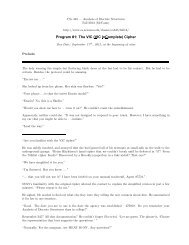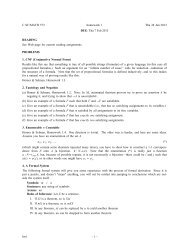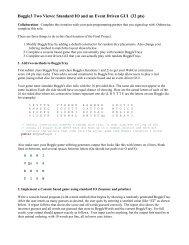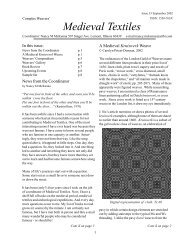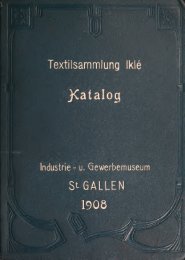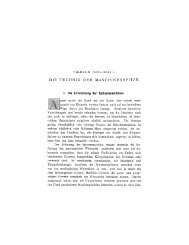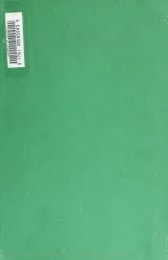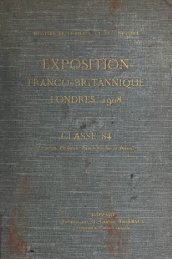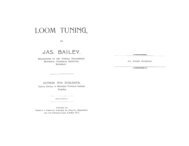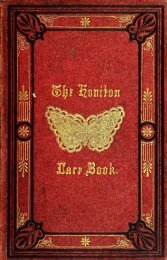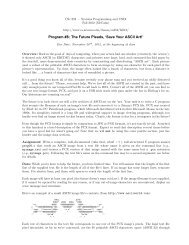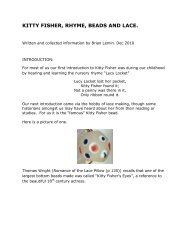The Priscilla Battenberg and point lace book; a collection of lace ...
The Priscilla Battenberg and point lace book; a collection of lace ...
The Priscilla Battenberg and point lace book; a collection of lace ...
You also want an ePaper? Increase the reach of your titles
YUMPU automatically turns print PDFs into web optimized ePapers that Google loves.
Insertion.<br />
Fig. 116. Le.vf Insertion.<br />
connect with<br />
the braid at all,<br />
<strong>and</strong> <strong>of</strong>ten the<br />
working thread<br />
must be carried<br />
along the ring<br />
until the desired<br />
location for the<br />
beginning <strong>of</strong> the<br />
next bar is<br />
located. <strong>The</strong><br />
last time the<br />
thread e n ters<br />
the ring a<br />
covering <strong>of</strong><br />
close button-<br />
hole stitches is<br />
worked over it.<br />
A pretty little insertion is shown in Fig. 115.<br />
A single buttonhole stitch is worked at regu-<br />
lar intervals into the braid along the entire<br />
length <strong>of</strong> one side <strong>of</strong> the space. <strong>The</strong> same<br />
treatment is given to the other side with the<br />
stitches p<strong>lace</strong>d exactly opposite those <strong>of</strong> the<br />
first <strong>and</strong> the working thread passed once<br />
through each loop <strong>of</strong> the opposite row. Should<br />
the space vary in width at any <strong>point</strong> the connecting<br />
<strong>of</strong> the two sides may be omitted, <strong>and</strong><br />
after the buttonholing <strong>of</strong> the second side has<br />
been completed the working thread carried down<br />
the open space <strong>and</strong> a single buttonhole stitch<br />
worked into each loop alternately. This re-<br />
sults in a plain Russian stitch worked into the<br />
loops instead <strong>of</strong> into the braids. In wider separations<br />
<strong>of</strong> the braid the working thread may<br />
be passed once into each free loop <strong>and</strong> the whole<br />
drawn up <strong>and</strong> either buttonholed closely or<br />
overcast several times more, <strong>and</strong> then, if the<br />
Fig. 117. Diamond Db.sign in Brussels Net.<br />
44<br />
size <strong>of</strong> the enclosed space warrants, filled in<br />
with any preferred web or stitch.<br />
Leaf Insertion.<br />
A very h<strong>and</strong>some insertion is shown in Fig.<br />
116 <strong>and</strong> may be varied as the ingenuity <strong>of</strong> the<br />
worker may dictate. <strong>The</strong> working thread is<br />
secured at one end <strong>of</strong> the space, carried across,<br />
entered into the braid, <strong>and</strong> overcast or twisted<br />
back to the <strong>point</strong> at which the first leaf is to<br />
be worked. Here it is secured by a single buttonhole<br />
knot left just loose enough to admit<br />
the needle, <strong>and</strong> from this <strong>point</strong> is entered into<br />
the braid on the side <strong>and</strong> at the location at<br />
which the lower end <strong>of</strong> the leaf is to be. It is<br />
then overcast one or two stitches along the<br />
braid <strong>and</strong> carried back into the buttonhole knot<br />
in the midrib. From here it is again entered<br />
into the braid to form the third rib <strong>of</strong> the leaf,<br />
overcast back to <strong>and</strong> passed through the but-<br />
tonhole knot.<br />
This results<br />
in two single<br />
<strong>and</strong> one<br />
twisted brfr<br />
upon which<br />
to work the<br />
leaf <strong>and</strong><br />
brings the<br />
working<br />
thread to the<br />
starting<br />
<strong>point</strong> <strong>of</strong> the<br />
w e a V i n g ,<br />
which is done Fig. 118. Net Stitch in Circles, t<br />
b y passing<br />
it over <strong>and</strong> under the bars or ribs until a leaf<br />
<strong>of</strong> solid weaving <strong>of</strong> sufficient size has been made.<br />
<strong>The</strong> working thread is then passed down<br />
through the weaving to the base <strong>of</strong> the leaf<br />
<strong>and</strong> the overcasting <strong>of</strong> the midrib then continued<br />
by twisting to the <strong>point</strong> on the opposite side<br />
<strong>of</strong> the space at which the second leaf is to be<br />
located.<br />
<strong>The</strong> illustration shows three varieties <strong>of</strong> these<br />
leaves. <strong>The</strong> first is the simple three-ribbed fan.<br />
<strong>The</strong> second is a fan <strong>of</strong> five ribs <strong>and</strong> may be<br />
varied <strong>and</strong> given a <strong>point</strong>ed or leaf shape by<br />
dropping the two outside bars when the leaf<br />
is half finished <strong>and</strong> continuing the weaving over<br />
the three inner ones only. A third leaf is shown,<br />
which is given the curved leaf shape by slightly<br />
drawing the last few rows <strong>of</strong> weaving to conform<br />
to the shape desired.



